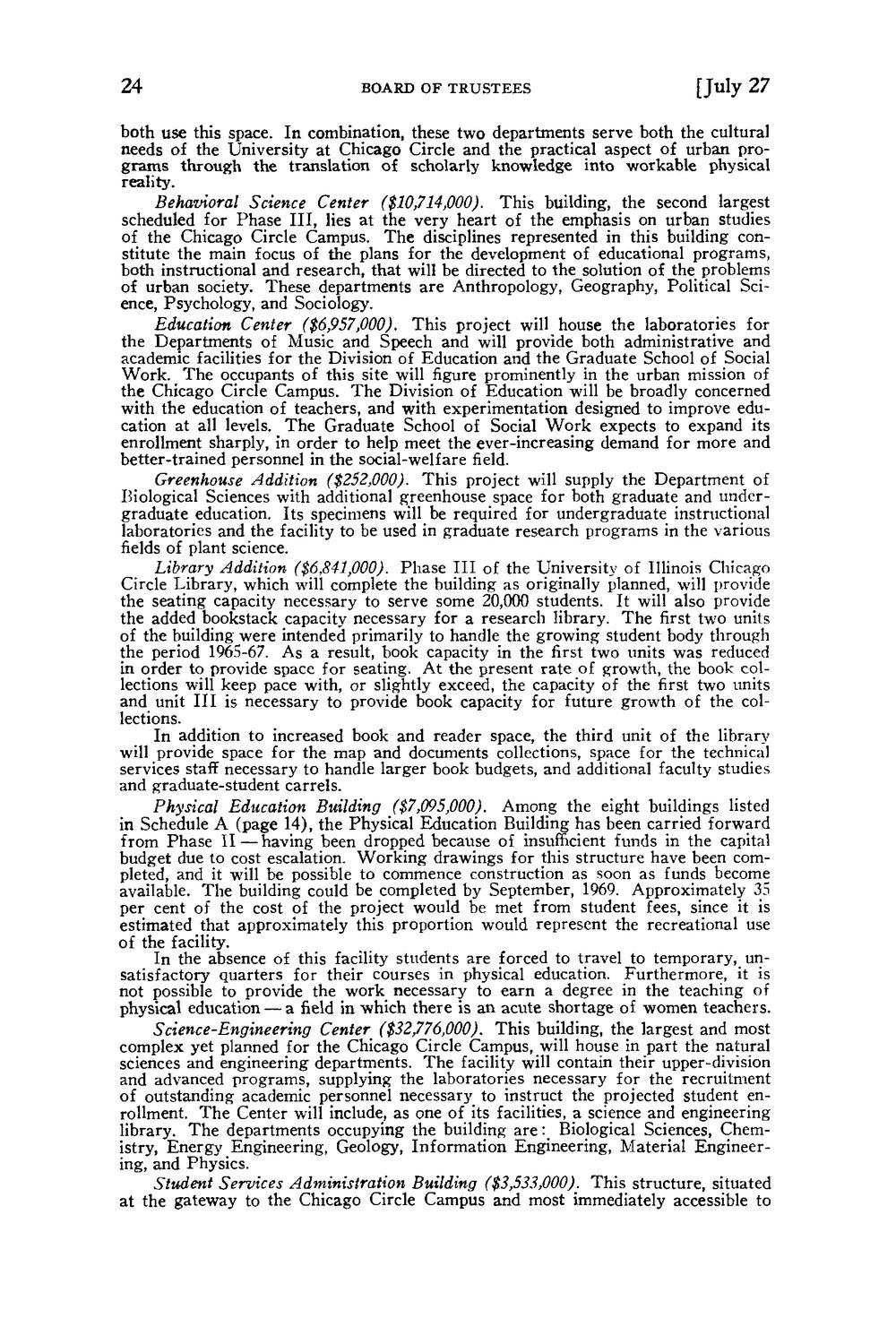| |
| |
Caption: Board of Trustees Minutes - 1968
This is a reduced-resolution page image for fast online browsing.

EXTRACTED TEXT FROM PAGE:
24 BOARD OF TRUSTEES [July 27 both use this space. In combination, these two departments serve both the cultural needs of the University at Chicago Circle and the practical aspect of urban programs through the translation of scholarly knowledge into workable physical reality. Behavioral Science Center ($10,714,000). This building, the second largest scheduled for Phase I I I , lies at the very heart of the emphasis on urban studies of the Chicago Circle Campus. The disciplines represented in this building constitute the main focus of the plans for the development of educational programs, both instructional and research, that will be directed to the solution of the problems of urban society. These departments are Anthropology, Geography, Political Science, Psychology, and Sociology. Education Center ($6,957,000). This project will house the laboratories for the Departments of Music and Speech and will provide both administrative and academic facilities for the Division of Education and the Graduate School of Social Work. The occupants of this site will figure prominently in the urban mission of the Chicago Circle Campus. The Division of Education will be broadly concerned with the education of teachers, and with experimentation designed to improve education at all levels. The Graduate School of Social W o r k expects to expand its enrollment sharply, in order to help meet the ever-increasing demand for more and better-trained personnel in the social-welfare field. Greenhouse Addition ($252,000). This project will supply the Department of Biological Sciences with additional greenhouse space for both graduate and undergraduate education. Its specimens will be required for undergraduate instructional laboratories and the facility to be used in graduate research programs in the various fields of plant science. Library Addition ($6,841,000). Phase I I I of the University of Illinois Chicago Circle Library, which will complete the building as originally planned, will provide the seating capacity necessary to serve some 20,000 students. It will also provide the added bookstack capacity necessary for a research library. The first two units of the building were intended primarily to handle the growing student body through the period 1965-67. As a result, book capacity in the first two units was reduced in order to provide space for seating. At the present rate of growth, the book collections will keep pace with, or slightly exceed, the capacity of the first two units and unit I I I is necessary to provide book capacity for future growth of the collections. In addition to increased book and reader space, the third unit of the library will provide space for the map and documents collections, space for the technical services staff necessary to handle larger book budgets, and additional faculty studies and graduate-student carrels. Physical Education Building ($7,095,000). Among the eight buildings listed in Schedule A (page 14), the Physical Education Building has been carried forward from Phase II —having been dropped because of insufficient funds in the capital budget due to cost escalation. Working drawings for this structure have been completed, and it will be possible to commence construction as soon as funds become available. The building could be completed by September, 1969. Approximately 35 per cent of the cost of the project would be met from student fees, since it is estimated that approximately this proportion would represent the recreational use of the facility. In the absence of this facility students are forced to travel to temporary, unsatisfactory quarters for their courses in physical education. Furthermore, it is not possible to provide the work necessary to earn a degree in the teaching of physical education — a field in which there is an acute shortage of women teachers. Science-Engineering Center ($32,776,000). This building, the largest and most complex yet planned for the Chicago Circle Campus, will house in part the natural sciences and engineering departments. The facility will contain their upper-division and advanced programs, supplying the laboratories necessary for the recruitment of outstanding academic personnel necessary to instruct the projected student enrollment. The Center will include, as one of its facilities, a science and engineering library. The departments occupying the building a r e : Biological Sciences, Chemistry, Energy Engineering, Geology, Information Engineering, Material Engineering, and Physics. Student Services Administration Building ($3,533,000). This structure, situated at the gateway to the Chicago Circle Campus and most immediately accessible to
| |